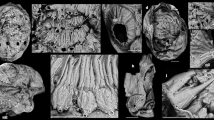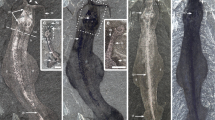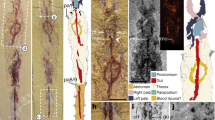Abstract
Euthycarcinoids are one of the most enigmatic arthropod groups, having been assigned to nearly all major clades of Arthropoda. Recent work has endorsed closest relationships with crustaceans1 or a myriapod–hexapod assemblage2, a basal position in the Euarthropoda3, or a placement in the Hexapoda4 or hexapod stem group5. Euthycarcinoids are known from 13 species ranging in age from Late Ordovician or Early Silurian to Middle Triassic, all in freshwater or brackish water environments6. Here we describe a euthycarcinoid from marine strata in Argentina dating from the latest Cambrian period, extending the group's record back as much as 50 million years. Despite its antiquity and marine occurrence, the Cambrian species demonstrates that morphological details were conserved in the transition to fresh water. Trackways in the same unit as the euthycarcinoid strengthen arguments that similar traces of subaerial origin from Cambro-Ordovician rocks were made by euthycarcinoids7,8. Large mandibles in euthycarcinoids6,9 are confirmed by the Cambrian species. A morphology-based phylogeny resolves euthycarcinoids as stem-group Mandibulata, sister to the Myriapoda and Crustacea plus Hexapoda.
This is a preview of subscription content, access via your institution
Access options
Subscribe to this journal
Receive 51 print issues and online access
$199.00 per year
only $3.90 per issue
Buy this article
- Purchase on Springer Link
- Instant access to full article PDF
Prices may be subject to local taxes which are calculated during checkout




Similar content being viewed by others
References
Wilson, H. M. & Almond, J. E. New euthycarcinoids and an enigmatic arthropod from the British Coal Measures. Palaeontology 44, 143–156 (2001)
Edgecombe, G. D. & Morgan, H. Synaustrus and the euthycarcinoid puzzle. Alcheringa 23, 193–213 (1999)
Schram, F. R. & Emerson, M. J. Arthropod Pattern Theory: a new approach to arthropod phylogeny. Mem. Qld. Mus. 31, 1–18 (1991)
Wills, M. A., Briggs, D. E. G., Fortey, R. A., Wilkinson, M. & Sneath, P. H. A. in Arthropod Fossils and Phylogeny (ed. Edgecombe, G. D.) 33–105 (Columbia Univ. Press, New York, 1998)
McNamara, K. J. & Trewin, N. H. A euthycarcinoid arthropod from the Silurian of Western Australia. Palaeontology 36, 319–335 (1993)
Anderson, L. I. & Trewin, N. H. An Early Devonian arthropod fauna from the Windyfield cherts, Aberdeenshire, Scotland. Palaeontology 46, 467–509 (2003)
MacNaughton, R. B. et al. First steps on land: Arthropod trackways in Cambrian-Ordovician eolian sandstone, southeastern Ontario, Canada. Geology 30, 391–394 (2002)
Trewin, N. H. & McNamara, K. J. Arthropods invade the land: Trace fossils and palaeoenvironments of the Tumblagooda Sandstone (?Late Silurian) of Kalbarri, Western Australia. Trans. R. Soc. Edin. Earth Sci. 85, 117–210 (1995)
Gall, J.-C. & Grauvogel, L. Un arthropode peu connu. Le genre Euthycarcinus Handlirsch. Ann. Paléontol. Invert. 50, 1–18 (1964)
Tortello, M. F. & Esteban, S. B. Trilobites del Cámbrico Tardio de la Formación Lampazar (sierra de Cajas, Jujuy, Argentina). Implicancias bioestratigráficas y paleoambientales. Ameghiniana 40, 323–344 (2003)
Buatois, L. A. & Mángano, M. G. Sedimentary facies and depositional evolution of the Upper Cambrian-Lower Ordovician Santa Rosita Formation in Northwest Argentina. J. S. Am. Earth Sci. 16, 343–363 (2003)
Bergström, J. Morphology and systematics of early arthropods. Abh. Naturw. Ver. Hamb. 23, 7–42 (1980)
Schram, F. R. & Rolfe, W. D. I. New euthycarcinoid arthropods from the Upper Pennsylvanian of France and Illinois. J. Paleontol. 56, 1434–1450 (1982)
Schultka, S. Erster Nachweis der Gattung Euthycarcinus (Arthropoda) aus dem Oberkarbon von Ibbenbüren (Nordrhein-Westfalen, Deutschland). Paläontologische Zeitschrift 65, 319–332 (1991)
Bitsch, J. The arthropod mandible: morphology and evolution. Phylogenetic implications. Ann. Soc. Entomol. Fr. 37, 305–321 (2001)
Edgecombe, G. D., Richter, S. & Wilson, G. D. F. The mandibular gnathal edges: homologous structures across the Mandibulata? Afr. Invert. 44, 115–135 (2003)
Kusche, K., Hembach, A., Hagner-Holler, S., Gebauer, W. & Burmester, T. Complete subunit sequences, structure and evolution of the 6 × 6-mer hemocyanin from the common house centipede, Scutigera coleoptrata. Eur. J. Biochem. 270, 2860–2868 (2003)
Mallatt, J. M., Garey, J. R. & Shultz, J. W. Ecdysozoan phylogeny and Bayesian inference: first use of nearly complete 28S and 18S rRNA gene sequences to classify the arthropods and their kin. Mol. Phylogenet. Evol. 31, 178–191 (2004)
Negrisolo, E., Minelli, A. & Valle, G. The mitochondrial genome of the house centipede Scutigera and the monophyly versus paraphyly of myriapods. Mol. Biol. Evol. 21, 770–780 (2004)
Richter, S. The Tetraconata concept: hexapod-crustacean relationships and the phylogeny of Crustacea. Org. Divers. Evol. 2, 217–237 (2002)
Farris, J. S. A successive approximations approach to character weighting. Syst. Zool. 18, 374–385 (1969)
Goloboff, P. A. Estimating character weights during tree search. Cladistics 9, 83–91 (1993)
Müller, C. H. G., Rosenberg, J., Richter, S. & Meyer-Rochow, V. B. The compound eye of Scutigera coleoptrata (Linnaeus, 1758) (Chilopoda: Notostigmophora): an ultrastructural reinvestigation that adds support to the Mandibulata concept. Zoomorphology 122, 191–209 (2003)
Trewin, N. H. A draft system for the identification and description of arthropod trackways. Palaeontology 37, 811–823 (1994)
Author information
Authors and Affiliations
Corresponding author
Ethics declarations
Competing interests
The authors declare that they have no competing financial interests.
Supplementary information
Supplementary Information
This includes a list of the characters used in phylogenetic analysis, and supplementary references. (DOC 199 kb)
Supplementary Table
Taxa and character codings used in the phylogenetic analysis. (DOC 58 kb)
Rights and permissions
About this article
Cite this article
Vaccari, N., Edgecombe, G. & Escudero, C. Cambrian origins and affinities of an enigmatic fossil group of arthropods. Nature 430, 554–557 (2004). https://doi.org/10.1038/nature02705
Received:
Accepted:
Issue Date:
DOI: https://doi.org/10.1038/nature02705
This article is cited by
Trace fossil evidence for infaunal moulting in a Middle Devonian non-trilobite euarthropod
Scientific Reports (2020)
Tectonic controls on late Cambrian-Early Ordovician deposition in Cordillera oriental (Northwest Argentina)
International Journal of Earth Sciences (2020)
The appendicular morphology of Sinoburius lunaris and the evolution of the artiopodan clade Xandarellida (Euarthropoda, early Cambrian) from South China
BMC Evolutionary Biology (2019)
Burgess Shale fossils illustrate the origin of the mandibulate body plan
Nature (2017)
Comments
By submitting a comment you agree to abide by our Terms and Community Guidelines. If you find something abusive or that does not comply with our terms or guidelines please flag it as inappropriate.



